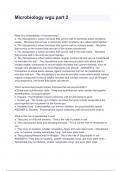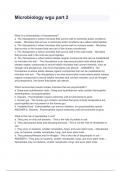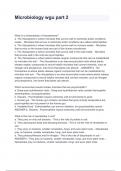Extremophiles - Study guides, Class notes & Summaries
Looking for the best study guides, study notes and summaries about Extremophiles? On this page you'll find 168 study documents about Extremophiles.
All 168 results
Sort by
 Popular
Popular
-
OPENSTAX MICROBIOLOGY TEST BANK (COVERS CHAPTER 1-26 OF THE BOOK) Complete Guide. Latest Update 2024
- Exam (elaborations) • 553 pages • 2024
-
- $17.48
- 1x sold
- + learn more
Opens tax Microbiology Test Bank Chapter 1 : An Invisible World Chapter 2 : How We See the Invisible World Chapter 3 : The Cell Chapter 4 : Prokaryotic Diversity Chapter 5 : The Eukaryotes of Microbiology Chapter 6 : Acellular Pathogens Chapter 7 : Microbial Biochemistry Chapter 8 : Microbial Metabolism Chapter 9 : Microbial Growth Chapter 10 : Biochemistry of the Genome Chapter 11 : Mechanisms of Microbial Genetics Chapter 12 : Modern Applications of Microbial Genetics Chapter 13 :...

-
BIO 117 Exam 2 Latest Update Already Passed
- Exam (elaborations) • 51 pages • 2024
-
Available in package deal
-
- $11.99
- + learn more
BIO 117 Exam 2 Latest Update Already Passed sexual fungal reproduction 1. plasmogamy 2. heterokaryotic mycelium 3. karyogamy heterokaryotic mycelium cells contain 2 haploid nuclei from parent (n+n) karyogamy fusion of nuclei from parents (2n) three domains of life bacteria, archaea, eukarya methods of gene exchange for bacteria 1. transformation 2. conjugation 3. transduction transduction -viruses/bacteriophages help to pass genetic information -required initial virus...

-
BIO 182 Exam #3 Study Guide. With Complete Solution, 100% correct. Updated 2024/5.
- Exam (elaborations) • 12 pages • 2024
-
Available in package deal
-
- $12.49
- + learn more
BIO 182 Exam #3 Study Guide. With Complete Solution, 100% correct. Updated 2024/5. Understand the phylogenetic tree of the three Domains of life. How are they related to each other? (Where are the branches, what is closer related to what?) What Domain of prokaryotes are the extremophiles? Korarchaeota -Primarily known from DNA samples of hot springs Euryachaeota -Methane producers, extreme halophiles, and some hyperthermophiles Crenarchaeota -Grow in extreme hot or cold and others in wid...

-
BIOD 101 Exam 2 (Questions and Answers A+ Graded 100% Verified)
- Exam (elaborations) • 2 pages • 2023
-
Available in package deal
-
- $7.99
- 6x sold
- + learn more
BIOD 101 Exam 2 (Questions and Answers A+ Graded 100% Verified) List the 7 most widely accepted characteristics of living organisms CORRECT ANS: Order, evolutionary adaptation, regulation, energy processing, growth and development, response to the environment, and reproduction Describe evolutionary adaptation and give an example CORRECT ANS: refers to smaller, genetic changes that allow for better survival of an organism. An example would be camouflage because if an animal can camo...

-
Microbiology wgu part 2 questions and answers
- Exam (elaborations) • 17 pages • 2024
-
- $7.99
- + learn more
What is a characteristic of rhizospheres? a. The rhizosphere is where microbes that survive well in extremely acidic conditions reside. - Microbes that survive in extremely acidic conditions are called extremophiles. b. The rhizosphere is where microbes that survive well on humans reside. - Microbes that survive on the human body are part of the human microbiome. c. The rhizosphere is where microbes that survive well in the cold reside. - Microbes that survive well in the cold are psychrop...

-
Microbiology wgu part 2 questions and answers
- Exam (elaborations) • 17 pages • 2024
-
- $7.99
- + learn more
What is a characteristic of rhizospheres? a. The rhizosphere is where microbes that survive well in extremely acidic conditions reside. - Microbes that survive in extremely acidic conditions are called extremophiles. b. The rhizosphere is where microbes that survive well on humans reside. - Microbes that survive on the human body are part of the human microbiome. c. The rhizosphere is where microbes that survive well in the cold reside. - Microbes that survive well in the cold are psychrop...

-
BIO 280 Test 1 Questions and Answers
- Exam (elaborations) • 27 pages • 2024
- Available in package deal
-
- $11.49
- + learn more
Why should we care about microorganisms Answer> They cause disease Microorganisms are ubiquitous Many are beneficial A typical gram of soil has______ Answer> 10⁹ different kinds of bacteria The human body has more _____ cells than than ______ cells Answer> bacterial, human Where are all these microorganism found in the human body? Answer> Skin Mouth Gi tract (10¹⁰ to 10¹³ cells/gram in large intestines) Respiratory tract Urogenital tract What do you call microorg...

-
Microbiology wgu part 2 test solved
- Exam (elaborations) • 17 pages • 2024
-
- $7.99
- + learn more
What is a characteristic of rhizospheres? a. The rhizosphere is where microbes that survive well in extremely acidic conditions reside. - Microbes that survive in extremely acidic conditions are called extremophiles. b. The rhizosphere is where microbes that survive well on humans reside. - Microbes that survive on the human body are part of the human microbiome. c. The rhizosphere is where microbes that survive well in the cold reside. - Microbes that survive well in the cold are psychrop...

-
Microbiology D311 - OA Prep 2025 Guaranteed Success
- Exam (elaborations) • 20 pages • 2024
-
Available in package deal
-
- $9.69
- + learn more
Microbiology D311 - OA Prep 2025 Guaranteed Success What is the main difference between Gram-positive and Gram-negative bacteria? ️️ Gram-positive bacteria have a thick peptidoglycan layer in their cell wall that retains the crystal violet stain, while Gram-negative bacteria have a thin peptidoglycan layer and an outer membrane that does not retain the stain. Describe the process of microbial respiration. ️️ Microbial respiration is the process by which microorganisms convert...

-
Bio 105 midterm Exam 2024 |Questions & 100% Correct Answers
- Exam (elaborations) • 14 pages • 2024
-
- $13.39
- + learn more
Life emerged on Earth shortly after the planet was formed, some BLANK years ago. - 3.8 billion Microbes are tiny living things that are found all around us and are too small to be seen by the naked eye. They live in water, soil, and in the air. The human body is home to millions of these microbes too, also called microorganisms - True Extremophiles are microbes that survive in intense conditions, such as very high or low temperatures. - True What is the difference between autotrophs and he...

-
BIO 280 Test 1 with Answers
- Exam (elaborations) • 14 pages • 2024
-
Available in package deal
-
- $12.99
- + learn more
Why should we care about microorganisms - They cause disease Microorganisms are ubiquitous Many are beneficial A typical gram of soil has______ - 10⁹ different kinds of bacteria The human body has more _____ cells than than ______ cells - bacterial, human Where are all these microorganism found in the human body? - Skin Mouth Gi tract (10¹⁰ to 10¹³ cells/gram in large intestines) Respiratory tract Urogenital tract What do you call microorganisms that live in extreme envi...

Study stress? For sellers on Stuvia, these are actually golden times. KA-CHING! Earn from your study resources too and start uploading now. Discover all about earning on Stuvia


